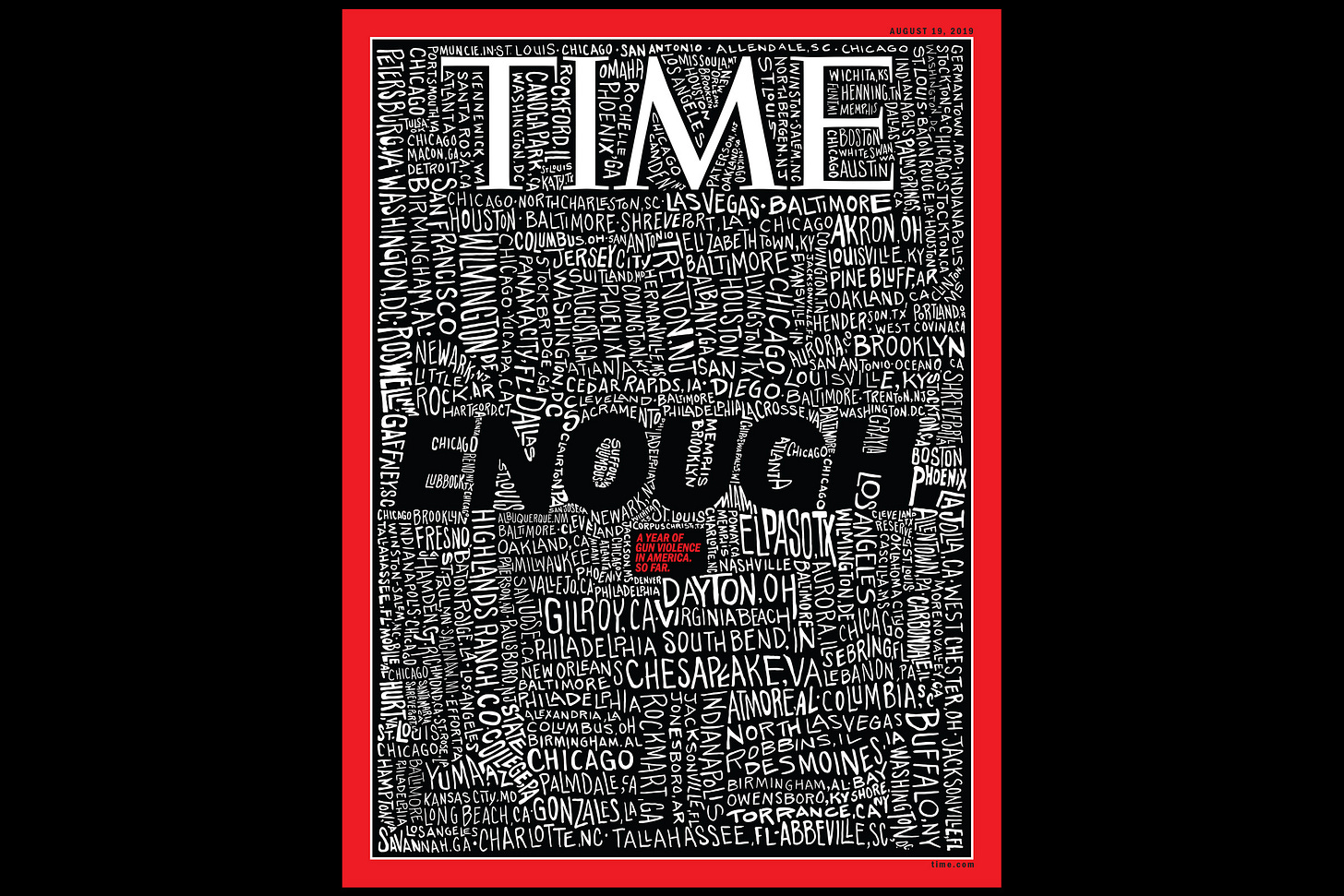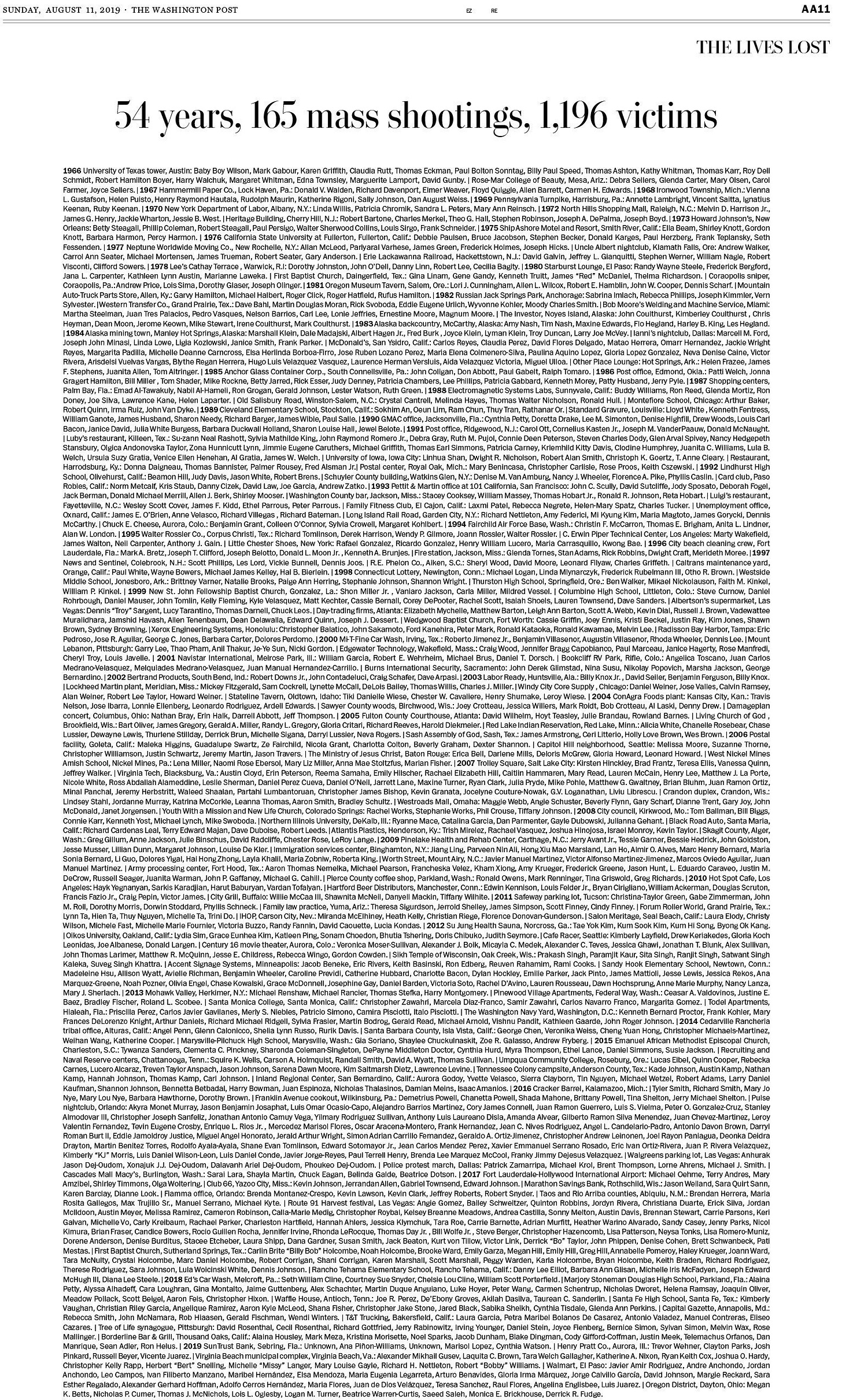Nota bene: Mass shootings

My friend Manu Saadia has a thing where he starts a bunch of his tweets with the phrase “I am going to say something very controversial but”. Once you get the joke it’s very funny; before you get the joke it can be a bit befuddling.
Recently, the American press seems, in unison, to have taken a leaf out of Manu’s book. You can’t swing a cat on #MediaTwitter without seeing a cover or a column which dares to declare: “I am going to say something very controversial but terrorism is bad.” Even the Trumpist New York Post has got in on the act!
This ubiquity of mass-shooting coverage is not entirely harmless. The phenomenon is a form of terrorism, after all, and it is increasingly effective at making Americans feel unsafe in public places. The vector for that terror — the mechanism by which Americans get scared — is the media. The more coverage that mass shootings receive, the more scared the country becomes.
While the media is doing a slightly better job at not turning the shooters themselves into antiheroes, it’s still flooding the zone every time one of these events happens. Mass shootings have become, in the public mind, the most salient way that Americans get killed. That’s on the media.
A typical column from the latest tranche of coverage comes from WSJ sports columnist Jason Gay. His headline is “Sticking to Sports vs. Being a Person in the World”; underneath that is the sub-hed “Thoughts after a harrowing weekend in America”.
Gay’s theme is simple. Normally, he writes about sports. He would love nothing more than to write about sports. But “it’s hard to avoid what’s happening in America right now. It’s difficult to gloss over a story like this, this kind of pain.” And so he writes about American’s pain, and its “vacuum of leadership,” and explains why he can’t ignore the pain to write about sports:
I don’t think we have the luxury of such detachment today. Not when extreme gun violence feels commonplace.
The curious thing is that of all the major issues facing America and the planet, this one — extreme gun violence — is the only one that could realistically find its way into that sentence.
That’s not because mass shootings are high up on the list of avoidable deaths. The fruit is hanging much lower, if you want to save lives, in areas like road safety, alcohol and tobacco use, prescription drug protocols, broadly accessible mental health services, improved maternal care, and much, much more.
Neither is addressing mass violence unique in its urgency and necessity. Race relations are hitting new lows in America every day, a pointless war is devastating Yemen, the entire planet is warming at a catastrophic pace. All of them are drivers of gun deaths, and would present a compelling need for action even if they weren’t.
Mass shootings are a relatively small phenomenon even by the standard of American gun deaths. Gun suicides kill many more people than mass killings, mostly with handguns, but you don’t see the editor of Time devoting multiple covers to the crisis of suicide, counting up how many lives banning handguns would save.
So, what is it about mass gun violence that uniquely sends journalists rushing for the moral high ground? Why is it this issue that causes Time editor Edward Felsenthal to admonish “leaders with the power to effect change”? Is there something specific to assault weaponry that induces NYT columnist Andrew Ross Sorkin to diagnose “an epidemic that law enforcement and politicians are unable or unwilling to manage,” and demand that the CEO of Walmart use his corporate power to “solve” the mass-shooting crisis?
One possible answer — considered and rejected — is that mass gun violence is particularly easy to prevent. Just ban assault weapons, and mass shootings will be reduced dramatically if not eliminated entirely. If you believe this, I’m not going to try to change your mind. But even if it’s true, it doesn’t really explain the media phenomenon. Normally, the US press is perfectly happy to simply report on possible solutions, without crossing the line into outright advocacy.
A second theory is that what we’re seeing is best understood as a reaction to a sustained terrorist campaign. After all, the one thing that terrorism is very good at, wherever it appears, is uniting people against it. America is a deeply divided nation, and is only going to become more so as the 2020 election approaches. Set against such a fractious and febrile backdrop, terrorism does exactly what it says on the tin — it creates the feeling that no one is safe. In doing so, it acts as a rare unifying force.
I’m going to reject this theory too. For every voice calling out white-suprematist terrorism, there’s another voice shouting about gun rights, or claiming that racism really isn’t a problem in America, or saying that it’s the anti-racists who are the real racists, or something like that. In order for terrorism to be a unifying force in America, there first needs to be a broad consensus that America is under terrorist attack. So far, that consensus has yet to form.
Which brings me to my third theory, which is that the media reaction to mass violence is in reality a sublimated and socially acceptable reaction to Trump.
Back in 2004, Daniel Okrent, then the public editor of the NYT, wrote a column under the headline “Is The New York Times a Liberal Newspaper?” — and famously answered the question, in his opening line, by saying “of course it is”. Today, he might say the same thing about Time, or the Washington Post, or even the news operation of the WSJ.
To be a journalist — to speak truth to power, to afflict the comfortable and comfort the afflicted — is at heart a liberal vocation, and there’s always something a bit unconvincing when editors in chief swear that their publications have no ideological ax to grind. Sure, they might not have an institutional position on, say, optimal trade policy, or whether or not the latest nuclear submarine should be funded. But it’s fair to say that, broadly, they’re anti-hate. That alone, in the era of Trump, is enough to give them a partisan bias.
There’s a very common form of marital argument which starts with one partner saying something ostensibly innocuous, and then the other partner getting very cross, and then the first partner putting on their best innocent face and saying that they didn’t say anything objectionable. Which might narrowly be true, even when both of them know what the fight is really about.
The media coverage of mass shootings feels similar, to me. It’s extremely good at pressing conservative buttons, because conservatives look at it and see an anti-Trump agenda. Then the liberal media can claim that they’re not targeting Trump at all, they’re just writing about domestic terrorism. Which, of course, only serves to annoy conservatives even further.
At the bottom of this email I’ve posted a striking page from Sunday’s WaPo, listing 1,196 victims of mass shootings since 1966. It’s worth noting that if the paper had decided to print instead the names of all the homicide victims in its home town of Washington DC just since 2010, the list would have been longer. I am going to say something very controversial, but there’s a reason why the paper chose to print this list rather than that one. And he’s currently the president of the United States.
To put it another way: Journalists have to maintain the appearance of objectivity. They can’t campaign directly against Trump or his policies. When they campaign instead against mass shootings, they get to vent their anger and frustration, while retaining a level of plausible deniability with respect to their own partisanship. The problem is that in doing so, they also play into the hands of the terrorists they’re campaigning against.


